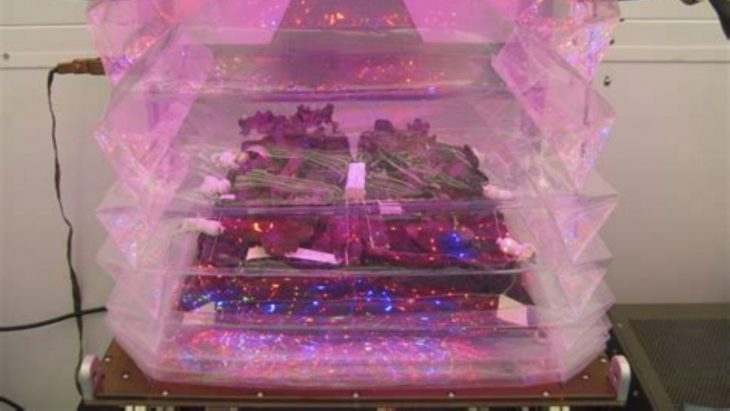Growing safe and healthy food in space is important for human space travel. NASA and supporting teams have been working on this issue for 40 years. Dr. Khodadad, along with a team at Kennedy Space Center and a crew on-board the International Space Station (ISS), grew lettuce to measure their nutrient content. They also wanted to understand if these crops might transmit foodborne illness to crew members.
The experimental study was conducted in one of NASA’s newer plant growth hardware models, the VEGGIE system, on the International Space Station. The growing chamber is a small, LED-lit container that is 1.7 square feet and 18 inches high. It is equipped with fans to circulate ISS air through the growing area. The study involved three experiments, VEG-01A, VEG-01B, and VEG-03A, which corresponded to two separate missions. The main difference in the experiments were the harvest dates of the experiments. Both VEG-01A and VEG-01B were fully harvested at day 33, while VEG-03A was first harvested at day 33, then weekly for 3 consecutive weeks, for a total of 4 harvests.
The lettuce used in this experiment was red Romaine lettuce, also known as ‘Outredgeous’ Lettuce. The seeds initially began the journey to the ISS packaged in seed pillows. These small pillows contained a specially designed wick to deliver water to the root system and slow-release fertilizer.
The focus of Dr. Khodadad’s research in this study was the microbial and nutritional content of the plants. Samples of the plants cut in space during harvest were flash frozen to be returned to Earth for analysis. To figure out what bacteria were on the lettuce, they used a technique called 16S rRNA community analysis, where a scientist collects all of the DNA from a sample and uses it to identify what bacterial species are there. They also used traditional culturing, where they grow the cells in Petri dishes instead of just taking their DNA. The team also measured the lettuce’s vitamin and mineral content.
There were no major differences in the microbial species present across the three experiments. The results showed that microbial counts on the samples were relatively low compared to farm and market produce counts on Earth. This means that the samples grown on the ISS showed similar levels of microbes as the plants we find at the store. All of this together means that, so far, space-grown lettuce is safe for humans to eat!
The nutrient content analysis of the crops showed differences in the levels of nutrients like potassium, iron, phosphorus, sulfur and zinc, but nothing that showed reason for concern. Experiment VEG-03A, the experiment harvested multiple times, was significantly lower in potassium and iron, but higher in phosphorus, sulfur and zinc, compared to the other two experiments. The reason for these differences are hard to pinpoint, but the authors suspect that it was a stress response by the plants while in space.
Although there were small differences in the type and quantity of bacteria on the different lettuce samples, there was no source or environmental factor that stood out as a cause. The authors explained that multiple factors such as temperature, humidity, water level, and human interaction could easily contribute to the small differences.
This experiment was a success, however, more research on growing plants in space needs to be done in order to better understand and prepare for the diets humans can sustain in space. There are very few studies on the food safety of space-grown produce in general. The idea of sustaining crops in space for years is daunting, but it must be done. This research is tackling that issue head on, hoping to help sustain humans on longer and more distant spaceflights.


